您好,登錄后才能下訂單哦!
您好,登錄后才能下訂單哦!
理論學習
問題1:簡述以太網發展史?
1. 使用同軸電纜組建以太網
2. 使用HUB組建以太網
3. 使用交換機組建的以太網
4. 使用路由器交換機配合組建局域網
5. 使用單臂路由技術組建局域網
6. 使用路由器交換機組建局域網
問題2:VLAN的概念及意義?
VLAN 概念:虛擬局域網是通過劃分邏輯信道減小廣播域,隔離物理網絡的一種交換機技術
VLAN 意義:減小網絡廣播域提升網絡通信效率;邏輯隔離增加網絡訪問的安全性;增加組網的靈活性
問題3:VLAN的類型有哪些?
靜態VLAN 和動態VLAN
靜態VLAN 是基于接口的VLAN
動態VLAN分四種:基于接口VLAN;基于MAC地址的VLAN;基于協議的VLAN;基于IP子網的VLAN;VLAN 幀的傳輸過程
問題4:訪問鏈路和中繼鏈路的區別是什么?
訪問鏈路:用于各VLAN成員接入,相應的接口稱之為訪問鏈路接口,接入的成員僅可以和同一VLAN內的其他成員通信,訪問鏈路常用于直接連接計算機
中繼鏈路:用于擴展VLAN的通信,相應的接口稱之為中繼鏈路接口,中繼鏈路常用于交換機之間的中繼鏈路接口連接,在建立中繼鏈路接口之后,兩端的交換機之間同一VLAN的成員可以互相通信,所以中繼鏈路常用于擴展VLAN的實現,中繼鏈路采用的協議有ISL和802.1Q。
問題5:本地VLAN和擴展VLAN的區別?
1. 如不跨交換機實現VLAN中繼,所有的VLAN配置僅在本地交換機起作用,這種VLAN配置方式稱為本地VLAN
VLAN 間邏輯間隔,除非采用VLAN間路由技術,否則各VLAN 不可通信;本地同一VLAN內主機可通信,在接口接收到以太網幀時打上VLAN標簽,傳輸到目的接口后將去除VLAN標簽;接入的連路僅適用訪問鏈路access,而無需中繼鏈路trunk,VLAN信息僅在本地起作用;
2. 通過VLAN中繼技術跨交換機實現同一VLAN內主機通信的技術稱之為擴展VLAN
可實現不同交換機的同一VALN內主機通信,但VLAN間邏輯間隔;兩端交換機都是cisco設備可使用ISL協議實現VALN中繼,否則使用802.1Q實現VALN中繼;各交換機上的VLAN劃分可以再各交換機上手工配置完成,也可以通過VTP協議自動實現
工作任務描述
位于同一樓層的A、B兩公司分別有若干臺計算機,這些計算機都直接連接在該樓層的同一臺交換機上,由于這兩個公司是獨立的公司,處于信息安全保護的考慮,不希望雙方的計算機之間進行通信,考慮該如何實現設備的配置。
工作任務實施
按基本任務要求進行網絡拓撲結構設計(粘貼PT的拓撲圖)
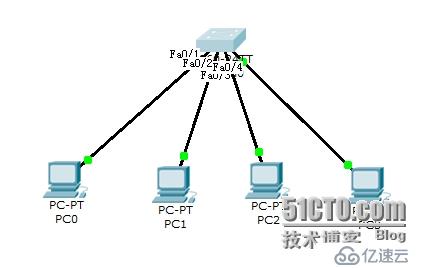
交換機的基本配置(本地VLAN配置)
(1) 配置交換機的VLAN信息
Switch>en
Switch#config
Configuring from terminal, memory, or network [terminal]?
Enter configuration commands, one per line. End with CNTL/Z.
Switch(config)#vlan 2
Switch(config-vlan)#name Acompany
Switch(config-vlan)#exi
Switch(config)#vlan 3
Switch(config-vlan)#name Bcompany
Switch(config-vlan)#exi
Switch(config)#in
Switch(config)#interface f0/1
Switch(config-if)#sw
Switch(config-if)#switchport a
Switch(config-if)#switchport access vlan 2
Switch(config-if)#in f0/2
Switch(config-if)#sw
Switch(config-if)#switchport a
Switch(config-if)#switchport m
Switch(config-if)#switchport mode a
Switch(config-if)#switchport mode access
Switch(config-if)#sw
Switch(config-if)#switchport a
Switch(config-if)#switchport access vlan 3
Switch(config-if)#in
Switch(config-if)#in f0/3
Switch(config-if)#sw
Switch(config-if)#switchport m
Switch(config-if)#switchport mode a
Switch(config-if)#switchport mode access
Switch(config-if)#sw
Switch(config-if)#switchport a
Switch(config-if)#switchport access vlan 2
Switch(config-if)#in f0/4
Switch(config-if)#sw
Switch(config-if)#switchport m
Switch(config-if)#switchport mode a
Switch(config-if)#switchport mode access
Switch(config-if)#sw
Switch(config-if)#switchport a
Switch(config-if)#switchport access vlan 3
Switch(config-if)#
(2) Ping測試及查看VLAN信息
測試:
Pc1可以ping通pc3,不可以ping通pc2
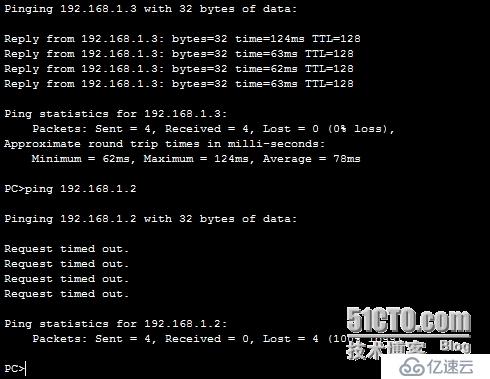
Pc2可以ping通pc4不可以ping通pc3
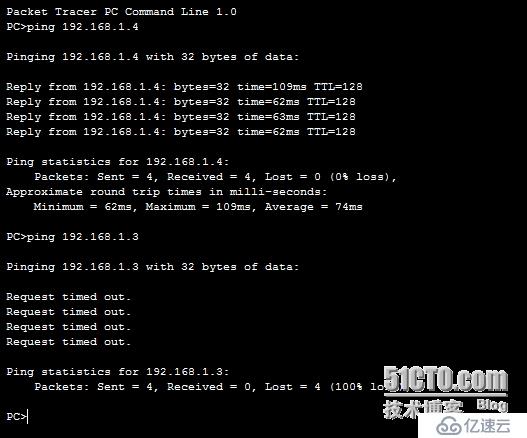
查看VLAN信息:
Switch#show vlan
VLAN Name Status Ports
---- -------------------------------- --------- -------------------------------
1 default active Fa0/5, Fa0/6, Fa0/7, Fa0/8
Fa0/9, Fa0/10, Fa0/11, Fa0/12
Fa0/13, Fa0/14, Fa0/15, Fa0/16
Fa0/17, Fa0/18, Fa0/19, Fa0/20
Fa0/21, Fa0/22, Fa0/23, Fa0/24
Gig1/1, Gig1/2
2 Acompany active Fa0/1, Fa0/3
3 Bcompany active Fa0/2, Fa0/4
1002 fddi-default act/unsup
1003 token-ring-default act/unsup
1004 fddinet-default act/unsup
1005 trnet-default act/unsup
VLAN Type SAID MTU Parent RingNo BridgeNo Stp BrdgMode Trans1 Trans2
---- ----- ---------- ----- ------ ------ -------- ---- -------- ------ ------
1 enet 100001 1500 - - - - - 0 0
2 enet 100002 1500 - - - - - 0 0
3 enet 100003 1500 - - - - - 0 0
1002 fddi 101002 1500 - - - - - 0 0
1003 tr 101003 1500 - - - - - 0 0
1004 fdnet 101004 1500 - - - ieee - 0 0
1005 trnet 101005 1500 - - - ibm - 0 0
Remote SPAN VLANs
------------------------------------------------------------------------------
Primary Secondary Type Ports
------- --------- ----------------- ------------------------------------------
Switch#
工作擴展
上述任務隨著兩個公司的場地變遷而發生了變化,現在A公司的PC1和B公司的PC2連接在同一臺交換機上,而A公司的PC3和B公司的PC4連接在另一臺交換機上,如果仍然需要實現公司內部計算機可以通信,兩公司之間不能通信,該如何進行設置?(擴展VLAN配置)
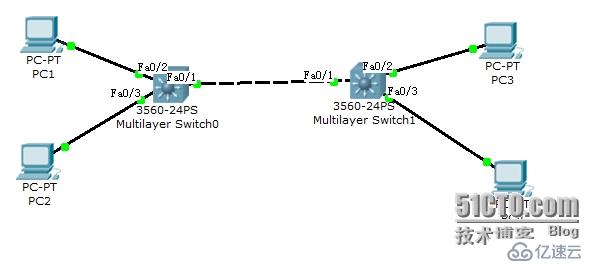
配置PC1和PC3在同一VLAN,PC2和PC4在同一VLAN
SW1:
Switch>
Switch>EN
Switch#config
Configuring from terminal, memory, or network [terminal]?
Enter configuration commands, one per line. End with CNTL/Z.
Switch(config)#hos
Switch(config)#hostname swich2
swich2(config)#vlan 2
swich2(config-vlan)#exi
swich2(config)#vlan 3
swich2(config-vlan)#exi
swich2(config)#in
swich2(config)#interface f0/1
swich2(config-if)#sw
swich2(config-if)#switchport t
swich2(config-if)#switchport trunk en
swich2(config-if)#switchport trunk encapsulation doq
swich2(config-if)#switchport trunk encapsulation dot
swich2(config-if)#switchport trunk encapsulation dot1q
swich2(config-if)#sw
swich2(config-if)#switchport m
swich2(config-if)#switchport mode t
swich2(config-if)#switchport mode trunk
%LINEPROTO-5-UPDOWN: Line protocol on Interface FastEthernet0/1, changed state to down
%LINEPROTO-5-UPDOWN: Line protocol on Interface FastEthernet0/1, changed state to up
swich2(config-if)#in
swich2(config-if)#in f0/2
swich2(config-if)#sw
swich2(config-if)#switchport m
swich2(config-if)#switchport mode a
swich2(config-if)#switchport mode access
swich2(config-if)#sw
swich2(config-if)#switchport a
swich2(config-if)#switchport access vlan 2
swich2(config-if)#in
swich2(config-if)#in f0/3
swich2(config-if)#sw
swich2(config-if)#switchport m
swich2(config-if)#switchport mode a
swich2(config-if)#switchport mode access
swich2(config-if)#s
swich2(config-if)#sw
swich2(config-if)#switchport a
swich2(config-if)#switchport access vlan 3
swich2(config-if)#exi
swich2(config)#
SW2:
Switch>EN
Switch#config
Configuring from terminal, memory, or network [terminal]?
Enter configuration commands, one per line. End with CNTL/Z.
Switch(config)#h
Switch(config)#hostname sw
Switch(config)#hostname switch3
switch3(config)#vlan 2
switch3(config-vlan)#exi
switch3(config)#vlan 3
switch3(config-vlan)#exi
switch3(config)#in
switch3(config)#interface f0/1
switch3(config-if)#sw
switch3(config-if)#switchport m
switch3(config-if)#switchport
switch3(config-if)#switchport
switch3(config-if)#switchport trunk en
switch3(config-if)#switchport trunk encapsulation do
switch3(config-if)#switchport trunk encapsulation dot1q
switch3(config-if)#sw
switch3(config-if)#switchport m
switch3(config-if)#switchport mode t
switch3(config-if)#switchport mode trunk
switch3(config-if)#in
switch3(config-if)#in f0/2
switch3(config-if)#sw
switch3(config-if)#switchport M
switch3(config-if)#switchport Mode a
switch3(config-if)#switchport Mode access
switch3(config-if)#sw
switch3(config-if)#switchport a
switch3(config-if)#switchport access vlan 2
switch3(config-if)#exi
switch3(config)#in
switch3(config)#interface f0/3
switch3(config-if)#sw
switch3(config-if)#switchport m
switch3(config-if)#switchport mode a
switch3(config-if)#switchport mode access
switch3(config-if)#sw
switch3(config-if)#switchport a
switch3(config-if)#switchport access vlan 3
switch3(config-if)#
檢查交換機1的trunk接口:
swich2#show interfaces trunk
Port Mode Encapsulation Status Native vlan
Fa0/1 on 802.1q trunking 1
Port Vlans allowed on trunk
Fa0/1 1-1005
Port Vlans allowed and active in management domain
Fa0/1 1,2,3
Port Vlans in spanning tree forwarding state and not pruned
Fa0/1 1,2,3
swich2#
兩兩測試,pc1和PC3可以PING通,PC2和PC4可以PING 通
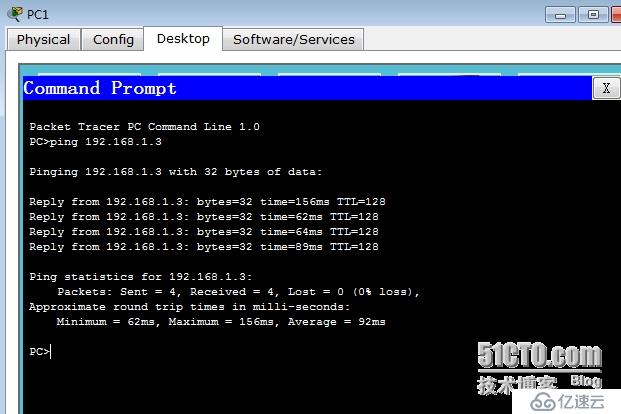
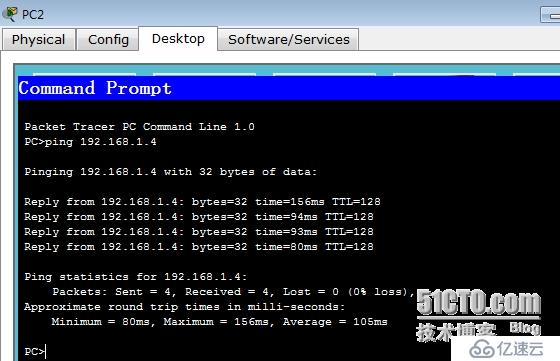
思考問題:
問題1:本征VLAN有什么作用?
本征vlan通過trunk鏈路傳輸各種vlan數據,僅對于trunk接口有效
免責聲明:本站發布的內容(圖片、視頻和文字)以原創、轉載和分享為主,文章觀點不代表本網站立場,如果涉及侵權請聯系站長郵箱:is@yisu.com進行舉報,并提供相關證據,一經查實,將立刻刪除涉嫌侵權內容。